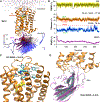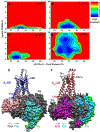Gaussian accelerated molecular dynamics (GaMD): principles and applications
- PMID: 34899998
- PMCID: PMC8658739
- DOI: 10.1002/wcms.1521
Gaussian accelerated molecular dynamics (GaMD): principles and applications
Abstract
Gaussian accelerated molecular dynamics (GaMD) is a robust computational method for simultaneous unconstrained enhanced sampling and free energy calculations of biomolecules. It works by adding a harmonic boost potential to smooth biomolecular potential energy surface and reduce energy barriers. GaMD greatly accelerates biomolecular simulations by orders of magnitude. Without the need to set predefined reaction coordinates or collective variables, GaMD provides unconstrained enhanced sampling and is advantageous for simulating complex biological processes. The GaMD boost potential exhibits a Gaussian distribution, thereby allowing for energetic reweighting via cumulant expansion to the second order (i.e., "Gaussian approximation"). This leads to accurate reconstruction of free energy landscapes of biomolecules. Hybrid schemes with other enhanced sampling methods, such as the replica exchange GaMD (rex-GaMD) and replica exchange umbrella sampling GaMD (GaREUS), have also been introduced, further improving sampling and free energy calculations. Recently, new "selective GaMD" algorithms including the ligand GaMD (LiGaMD) and peptide GaMD (Pep-GaMD) enabled microsecond simulations to capture repetitive dissociation and binding of small-molecule ligands and highly flexible peptides. The simulations then allowed highly efficient quantitative characterization of the ligand/peptide binding thermodynamics and kinetics. Taken together, GaMD and its innovative variants are applicable to simulate a wide variety of biomolecular dynamics, including protein folding, conformational changes and allostery, ligand binding, peptide binding, protein-protein/nucleic acid/carbohydrate interactions, and carbohydrate/nucleic acid interactions. In this review, we present principles of the GaMD algorithms and recent applications in biomolecular simulations and drug design.
Conflict of interest statement
Conflict of Interest The authors have declared no conflict of interest for this article.
Figures








Similar articles
-
Gaussian Accelerated Molecular Dynamics in NAMD.J Chem Theory Comput. 2017 Jan 10;13(1):9-19. doi: 10.1021/acs.jctc.6b00931. Epub 2016 Dec 30. J Chem Theory Comput. 2017. PMID: 28034310 Free PMC article.
-
Replica Exchange Gaussian Accelerated Molecular Dynamics: Improved Enhanced Sampling and Free Energy Calculation.J Chem Theory Comput. 2018 Apr 10;14(4):1853-1864. doi: 10.1021/acs.jctc.7b01226. Epub 2018 Mar 12. J Chem Theory Comput. 2018. PMID: 29489349 Free PMC article.
-
Replica-Exchange Umbrella Sampling Combined with Gaussian Accelerated Molecular Dynamics for Free-Energy Calculation of Biomolecules.J Chem Theory Comput. 2019 Oct 8;15(10):5199-5208. doi: 10.1021/acs.jctc.9b00761. Epub 2019 Sep 27. J Chem Theory Comput. 2019. PMID: 31539245
-
Binding Analysis Using Accelerated Molecular Dynamics Simulations and Future Perspectives.Adv Appl Bioinform Chem. 2022 Jan 6;15:1-19. doi: 10.2147/AABC.S247950. eCollection 2022. Adv Appl Bioinform Chem. 2022. PMID: 35023931 Free PMC article. Review.
-
Gaussian accelerated molecular dynamics for elucidation of drug pathways.Expert Opin Drug Discov. 2018 Nov;13(11):1055-1065. doi: 10.1080/17460441.2018.1538207. Epub 2018 Oct 29. Expert Opin Drug Discov. 2018. PMID: 30371112 Free PMC article. Review.
Cited by
-
Conformational States of the GDP- and GTP-Bound HRAS Affected by A59E and K117R: An Exploration from Gaussian Accelerated Molecular Dynamics.Molecules. 2024 Jan 30;29(3):645. doi: 10.3390/molecules29030645. Molecules. 2024. PMID: 38338389 Free PMC article.
-
Deep Learning Dynamic Allostery of G-Protein-Coupled Receptors.Res Sq [Preprint]. 2023 Feb 20:rs.3.rs-2543463. doi: 10.21203/rs.3.rs-2543463/v1. Res Sq. 2023. Update in: JACS Au. 2023 Nov 02;3(11):3165-3180. doi: 10.1021/jacsau.3c00503. PMID: 36865316 Free PMC article. Updated. Preprint.
-
Emerging Methods and Applications to Decrypt Allostery in Proteins and Nucleic Acids.J Mol Biol. 2022 Sep 15;434(17):167518. doi: 10.1016/j.jmb.2022.167518. Epub 2022 Feb 28. J Mol Biol. 2022. PMID: 35240127 Free PMC article. Review.
-
Deep Learning Dynamic Allostery of G-Protein-Coupled Receptors.bioRxiv [Preprint]. 2023 Feb 2:2023.01.15.524128. doi: 10.1101/2023.01.15.524128. bioRxiv. 2023. Update in: JACS Au. 2023 Nov 02;3(11):3165-3180. doi: 10.1021/jacsau.3c00503. PMID: 36711515 Free PMC article. Updated. Preprint.
-
Q61 mutant-mediated dynamics changes of the GTP-KRAS complex probed by Gaussian accelerated molecular dynamics and free energy landscapes.RSC Adv. 2022 Jan 11;12(3):1742-1757. doi: 10.1039/d1ra07936k. eCollection 2022 Jan 5. RSC Adv. 2022. PMID: 35425180 Free PMC article.
References
Grants and funding
LinkOut - more resources
Full Text Sources
Miscellaneous
